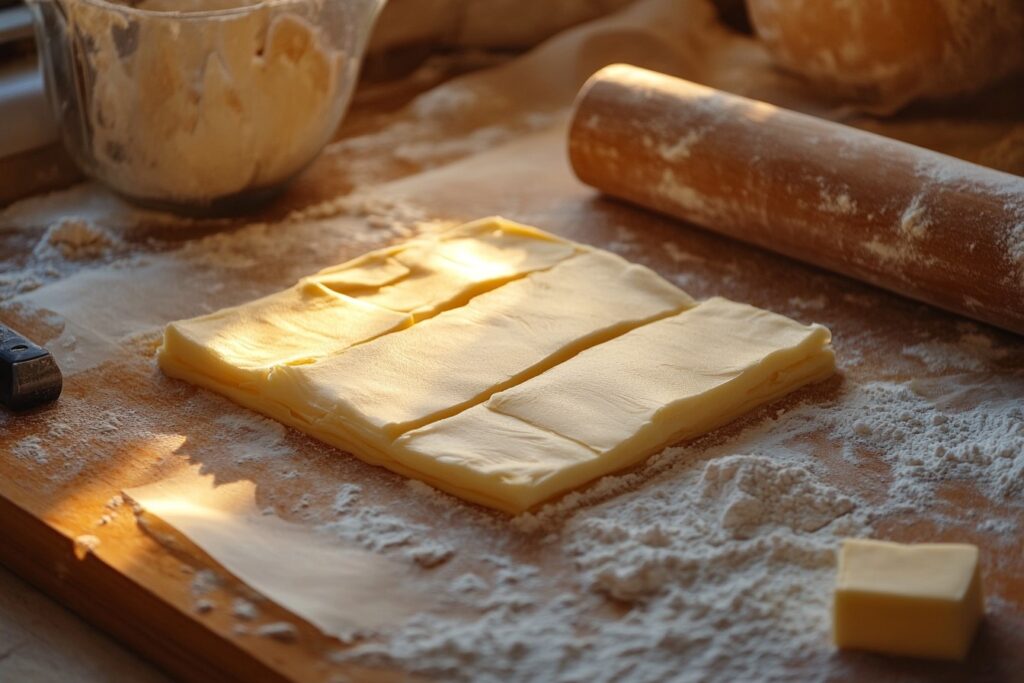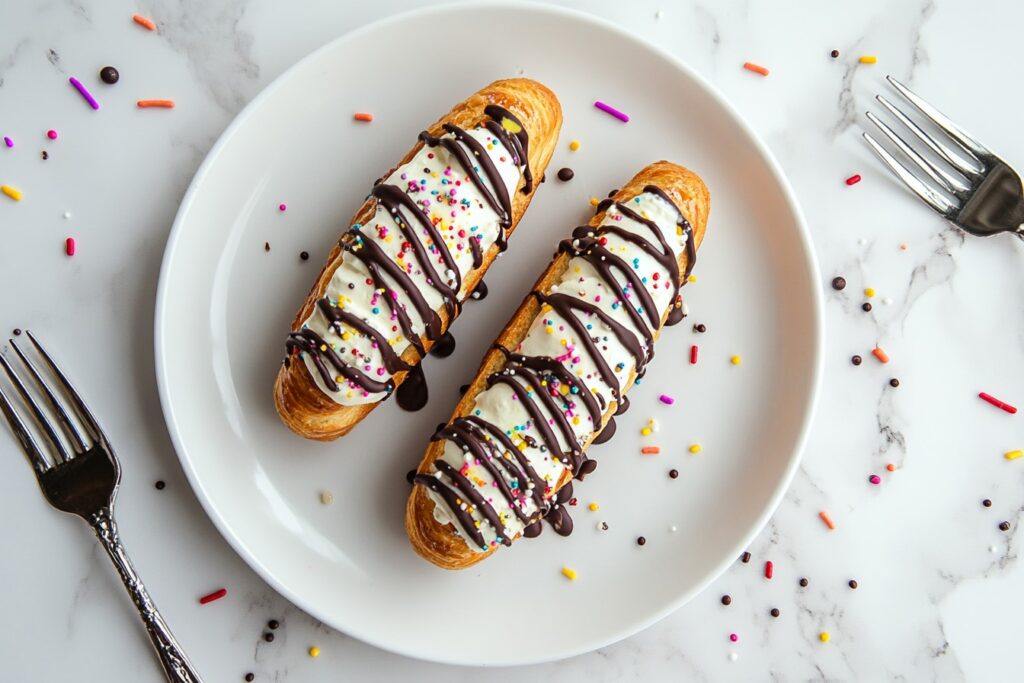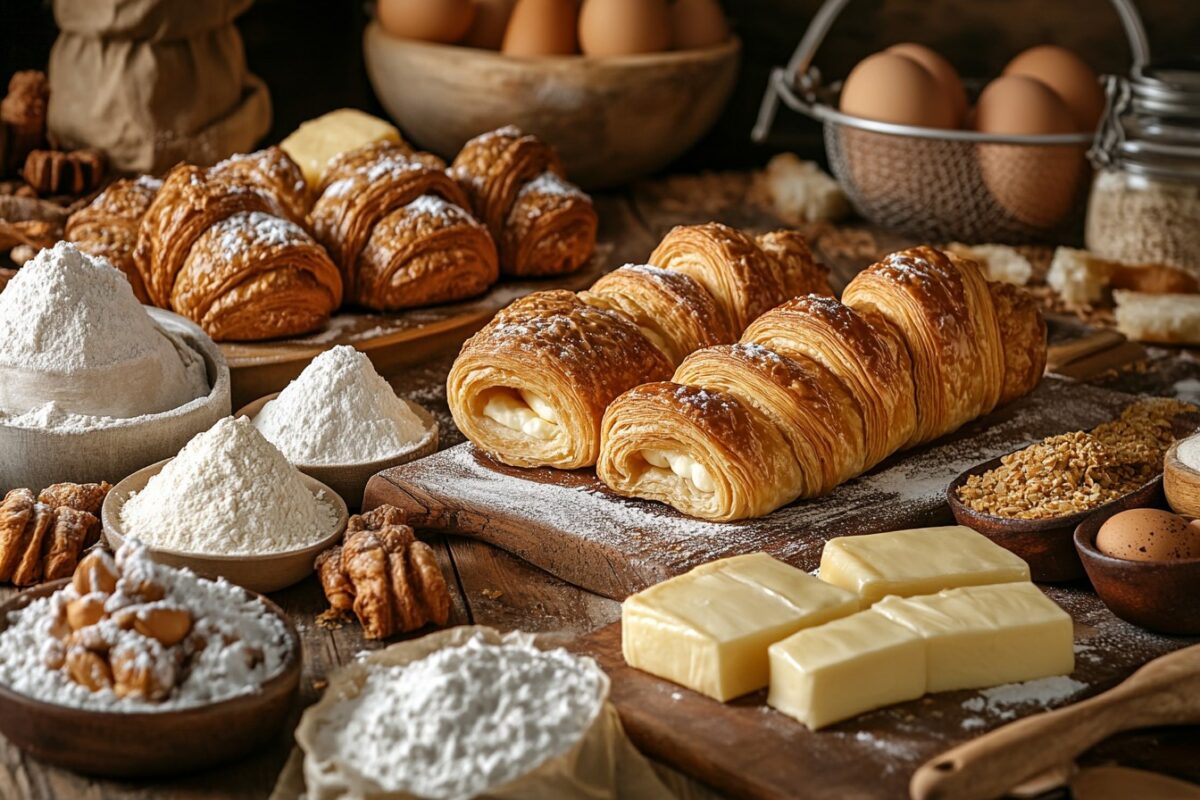Introduction
Pastries are the heart of many culinary traditions, combining artistry, technique, and deliciousness in every bite. From the flaky layers of puff pastry to the buttery simplicity of shortcrust, pastries play a vital role in kitchens worldwide. But what are the four basic pastries, and what makes each one unique? In this article, we’ll delve deep into the world of pastries, breaking down the fundamentals, exploring their ingredients and techniques, and uncovering the cultural significance behind these baked wonders. Whether you’re a home baker or a pastry enthusiast, this guide is your gateway to mastering the basics.
Understanding the Four Basic Types of Pastries
What Are the Four Main Types of Pastries?
Pastry, in its essence, is a dough made of flour, fat, and liquid that’s baked to create various sweet and savory delights. The four main types of pastries are shortcrust, puff, choux, and filo. Each type has distinct characteristics that define its use in the kitchen.
- Shortcrust pastry is the quintessential base for pies and tarts, celebrated for its crumbly, buttery texture.
- Puff pastry stands out with its flaky, multi-layered structure, perfect for desserts like croissants or savory vol-au-vents.
- Choux pastry, on the other hand, is light and airy, ideal for cream-filled confections like éclairs and profiteroles.
- Filo pastry, the thinnest and most delicate of the group, is synonymous with dishes like baklava and spanakopita.
Let’s explore each one in detail.
Shortcrust Pastry: The Foundation of Pies and Tarts
Shortcrust pastry is the go-to choice for many bakers, thanks to its simplicity and versatility. This type of pastry is crumbly and tender, making it a favorite for both sweet and savory dishes.
- Characteristics and Common Uses
Shortcrust pastry has a “short” texture, meaning it crumbles easily due to the high fat content. It’s widely used in pies, quiches, and tarts because of its sturdy yet tender structure. - Ingredients and Preparation Steps
Typically made with flour, butter, water, and a pinch of salt, shortcrust pastry is simple to prepare. The secret lies in working quickly to keep the butter cold, ensuring a flaky result. For a sweeter variation, sugar can be added to the mix.
Puff Pastry: The Layered Delight
Known for its flaky, buttery layers, puff pastry is a marvel of culinary engineering. It’s created through a labor-intensive laminating process that gives it its characteristic rise.
- What Makes Puff Pastry Unique?
Puff pastry owes its magic to the numerous layers of butter and dough folded together. When baked, the water in the dough and butter turns into steam, creating a light, flaky texture. - Culinary Uses
From desserts like palmiers and mille-feuille to savory options like sausage rolls, puff pastry is prized for its versatility and ability to elevate simple ingredients into gourmet creations.
Choux Pastry: The Airy Classic
If you’ve ever marveled at the delicate éclairs or cream puffs in a bakery, you’ve admired the work of choux pastry. This unique dough puffs up during baking, creating a hollow interior perfect for fillings.
- Its Light and Hollow Structure Explained
Choux pastry is made by cooking flour, water, and butter on the stovetop before adding eggs. This method creates a high-moisture dough that expands dramatically in the oven. - Applications in Éclairs, Cream Puffs, and Profiteroles
The hollow structure of choux pastry is ideal for holding sweet or savory fillings. Popular examples include éclairs filled with cream and topped with chocolate glaze or savory gougères flavored with cheese.
Filo Pastry: The Paper-Thin Essential
Filo (or phyllo) pastry is a delicate, paper-thin dough used in dishes that require a crisp, flaky texture. Unlike other pastries, filo isn’t layered but rather stacked with butter or oil brushed between the sheets.
- Texture and Flexibility
Filo is incredibly thin and fragile, making it challenging to handle but rewarding in its crispness when baked. Each layer becomes distinct yet cohesive in the final dish. - Dishes Like Baklava and Spanakopita
Filo is synonymous with Mediterranean and Middle Eastern cuisines. Desserts like baklava, with its syrup-soaked layers of filo and nuts, or savory dishes like spanakopita, highlight its versatility.
The Science Behind Pastry Making
What Are the Four Main Ingredients in Pastry?
At its core, pastry is a symphony of just four ingredients: flour, fat, water, and salt. These elements combine to create a wide variety of textures and flavors depending on how they’re mixed, handled, and baked.
- Flour: The Structural Base
Flour provides the framework for pastry. High-protein flours yield sturdy pastries, while low-protein flours (like cake flour) create tender textures, ideal for shortcrust. - Fat: Butter vs. Lard
Fat adds richness and texture. Butter is favored for its flavor, while lard can create extra flakiness. For a puff pastry, the quality of butter directly impacts the final layers. - Water: The Glue of Pastry Dough
Water binds the ingredients, but too much can ruin the dough. Achieving the right balance is key to avoiding a tough, chewy crust. - Salt: Enhancing Flavors
A pinch of salt balances sweetness and highlights other flavors in the dough.
How Different Techniques Shape Pastry Texture

The preparation method for each pastry type greatly influences its texture. These techniques aren’t just about following steps—they’re about chemistry in action.
- Laminating for Puff Pastry
Puff pastry owes its layers to the laminating process, where dough and butter are folded repeatedly. This technique traps steam during baking, creating the signature flakiness. - Cutting and Mixing for Shortcrusts
For shortcrust pastry, fat is “cut” into the flour until it resembles breadcrumbs. Minimal handling ensures a tender, crumbly texture.
Temperature’s Role in Pastry Success
Temperature control is a baker’s secret weapon. Whether you’re working with choux or filo, keeping ingredients and environments at the right temperature is crucial.
- Chilling Dough for Better Results
Cold butter in puff and shortcrust pastry prevents the fat from melting prematurely, ensuring flakiness. - Baking Temperatures for Each Pastry Type
High heat is essential for puff pastry to create lift, while moderate temperatures suit shortcrust to cook evenly without overbrowning.
By understanding these scientific principles, you can elevate your pastry game and master the art of creating flawless bakes.
Techniques for Perfect Pastries at Home
Tips for Working with Shortcrust Pastry
Shortcrust is known for its simplicity, but it still requires a careful hand to achieve perfection. Follow these tips to make it easier.
- Avoiding Overmixing
Overworking the dough develops gluten, making the pastry tough. Use light, quick motions to combine the ingredients. - Preventing Shrinkage
Letting the dough rest in the fridge before baking reduces shrinkage, keeping your crust crisp and even.
The Art of Layering Puff Pastry
Mastering puff pastry takes practice, but once you’ve got the hang of laminating, the possibilities are endless.
- Achieving Distinct Layers
Roll out the dough evenly and use consistent folds. Always chill the dough between steps to maintain those buttery layers. - Common Mistakes to Avoid
Using warm butter or overhandling the dough can disrupt layering. Keep the environment cool and your movements precise.
Mastering Choux Pastry: From Dough to Puffs
Choux pastry may seem intimidating, but a few tricks can make it easier to create those delightful puffs.
- Properly Mixing and Piping
Cook the flour and liquid thoroughly before adding eggs. When piping, ensure uniform sizes for even baking. - Importance of Steam During Baking
Steam is vital for choux pastry to rise. Bake at high heat initially to generate steam, then lower it to finish cooking.
Handling Filo Pastry Without Tears
Filo’s delicate nature demands patience, but its crispy results are worth the effort.
- Keeping It Moist During Preparation
Cover unused sheets with a damp towel to prevent drying out. Brush each layer with butter or oil for flavor and adhesion. - Layering with Precision
Use gentle hands to layer filo evenly. Uneven stacking can lead to uneven baking.
By following these techniques, you’ll be equipped to make pastries that are both delicious and beautiful. For more ideas on pastry recipes, you can explore Breakfast Pastry Recipes Guide for inspiration.
The Cultural and Culinary Significance of Pastries
How Different Cultures Use the Four Basic Pastries
Pastries are not just delicious—they’re a reflection of cultural identity. Across the globe, the four basic pastries—shortcrust, puff, choux, and filo—are transformed into iconic regional dishes.
- Shortcrust in Western Cuisine
In Western traditions, shortcrust pastry is the backbone of pies and tarts, from savory quiches in France to sweet fruit pies in the United States. Its buttery, crumbly texture is cherished in every bite. - Puff Pastry in French and Danish Delights
Puff pastry is synonymous with French baking, giving us delicacies like croissants and mille-feuille. Danish pastries also rely on this dough, though they incorporate additional fillings and toppings for a sweeter twist. - Choux Pastry’s Universal Appeal
From France’s éclairs and cream puffs to Italy’s zeppole, choux pastry serves as a canvas for both sweet and savory flavors. Its airy structure lends itself to endless creativity. - Filo Pastry in Mediterranean and Middle Eastern Fare
Filo’s delicate nature makes it the perfect vessel for baklava, a sweet dessert layered with honey and nuts. In Greece, spanakopita combines filo’s crunch with savory spinach and feta.
Pastries in Historical Context
Pastries have a rich history that dates back centuries, evolving alongside culinary traditions.
- Origins of Pastry Techniques
The first recorded pastry-making dates to ancient Egypt, where filo-like doughs were used in layered desserts. Over time, pastry techniques spread through trade and cultural exchange. - The Evolution of Modern Pastries
With the rise of French patisseries in the 17th century, pastries became a symbol of luxury. Advances in tools and techniques made complex creations like puff pastry accessible to skilled bakers.
These culinary traditions showcase how pastries have been shaped by culture, geography, and history. For more baking inspiration, explore Breakfast Pastry Recipes Guide.
FAQs About Pastries
What Are the Basics of Pastry?
Pastry starts with a mix of four simple ingredients: flour, fat, water, and salt. Mastering the balance between these is the foundation of great baking. The right handling, resting, and baking techniques transform these humble elements into flaky, buttery creations.
What Is the Most Basic Pastry?
Shortcrust pastry is often considered the easiest to prepare, making it the most basic pastry. Its simplicity lies in the quick mixing of flour, butter, and water, which creates a dough that’s both versatile and forgiving.
What Are the 4 Main Ingredients in Pastry?
The main ingredients—flour, fat, water, and salt—each play a crucial role:
- Flour provides structure.
- Fat ensures flakiness and richness.
- Water binds the dough.
- Salt enhances flavor.
What Are the Four Basic Pastries?
To recap, the four basic pastries are shortcrust, puff, choux, and filo. Each has its own unique qualities, from the tender crumb of shortcrust to the airy rise of choux. These types form the foundation for countless dishes and baking traditions.
By now, you have a deeper understanding of the magic behind pastries. For more creative ideas and tips, check out other recipes on Quinto Recipes. Happy baking!
Expert Tips for Perfecting Pastries

Common Mistakes to Avoid When Making Pastries
Even experienced bakers can encounter challenges while making pastries. By steering clear of common pitfalls, you can ensure consistent success every time.
- Overmixing the Dough
Overworking shortcrust or puff pastry dough can lead to tough textures. Always mix or knead just enough to bring the ingredients together, leaving the gluten strands intact but not overdeveloped. - Skipping the Resting Period
Resting the dough in the fridge isn’t optional—it’s essential. This step helps relax the gluten, ensuring a tender texture and preventing shrinkage during baking. - Ignoring Temperature Control
For puff and choux pastries, maintaining the right temperature is critical. Cold butter creates layers in puff pastry, while a hot oven ensures choux dough rises properly.
Tools That Make Pastry Preparation Easier
Having the right tools can take your pastry-making skills to the next level. Whether you’re a beginner or an expert, investing in high-quality equipment can make a big difference.
- Pastry Blender or Food Processor
These tools simplify the process of cutting fat into flour for shortcrust pastry, saving time and ensuring even mixing. - Rolling Pin and Pastry Mat
A smooth rolling pin and non-stick mat are essential for rolling out even layers of dough, particularly for puff and filo pastries. - Pastry Brush
Whether you’re brushing butter onto filo sheets or applying an egg wash, a good pastry brush is invaluable for adding flavor and finishing touches.
Perfecting Pastries with Practice
Every great pastry chef started with the basics. The key to mastering the four basic pastries—shortcrust, puff, choux, and filo—is practice and patience. Keep experimenting, and soon you’ll find yourself creating bakery-quality delights at home.
Wrapping Up and Exploring New Pastry Creations
Applying the Basics to Create Unique Pastries
Once you’ve mastered what are the four basic pastries, the next step is to explore their versatility. Each type of pastry can serve as a foundation for countless variations and new recipes.
- Shortcrust Innovations
Add herbs or spices to shortcrust dough for savory tarts, or mix in a hint of citrus zest for sweet desserts. You can also experiment with alternative flours like almond or whole wheat. - Creative Puff Pastry Ideas
Puff pastry is a playground for creativity. Try shaping it into pinwheels or braids, or use it to top pot pies for an elegant twist on comfort food. - Choux Pastry with a Twist
Flavor your choux dough with cocoa for chocolate éclairs, or incorporate cheese and herbs for savory gougères. - Filo Pastry Adventures
Use filo to craft intricate dessert parcels filled with fruit and nuts, or turn it into crunchy layers for a modern twist on tiramisu.
Encouraging Home Bakers to Experiment
Baking pastries at home doesn’t have to be daunting. By starting with the basics and building confidence through practice, you can turn simple ingredients into show-stopping creations.
If you’re feeling inspired, dive into more recipes like those featured in the Breakfast Pastry Recipes Guide. With each attempt, you’ll grow more skilled, unlocking the full potential of these classic pastry types.
Pairing Pastries with Flavors and Fillings
How to Complement Each Pastry Type
Choosing the right flavors and fillings can elevate your pastries, making them unforgettable. Understanding what are the four basic pastries can guide you in creating perfect pairings.
- Shortcrust Pastry Pairings
Shortcrust is incredibly versatile. For sweet creations, pair it with fruit fillings like apple or berry, or creamy custards. Savory options like quiche pair beautifully with vegetables, cheeses, and meats. - Flavors for Puff Pastry
Puff pastry is all about indulgence. Sweet fillings like almond cream or chocolate spread create heavenly desserts, while savory combinations like spinach and feta, or ham and cheese, make for satisfying snacks. - Creative Ideas for Choux Pastry
Choux is a blank canvas for bold flavors. Sweet fillings like vanilla cream, caramel, or fresh fruit balance its airy texture, while savory variations like smoked salmon mousse or herbed cream cheese transform it into an elegant appetizer. - Filo Pastry and Its Ideal Partners
The crisp, flaky texture of filo pairs well with rich fillings. For desserts, try nuts and honey, as in baklava, or fruits like apples and pears. On the savory side, lamb, spinach, or ricotta cheese create amazing dishes.
Balancing Flavors and Textures
The magic of pastries lies in balancing flavors and textures. A rich filling in a flaky pastry creates contrast, while pairing mild ingredients with strong flavors keeps the dish harmonious. Master this balance, and your pastries will always shine.
Why Mastering the Basics Matters
Building Confidence in Pastry Baking
Mastering what are the four basic pastries lays the groundwork for all your baking adventures. With these four types—shortcrust, puff, choux, and filo—you can confidently create both traditional recipes and innovative dishes.
- From Basics to Creativity
When you understand the techniques behind each pastry, you can experiment without fear. Knowing how to achieve a flaky crust or an airy choux dough means you’re equipped to tackle new challenges in the kitchen. - Enhancing Versatility in the Kitchen
Each pastry type is a tool for your creativity. Whether you’re making a savory pot pie with shortcrust, a breakfast pastry with puff dough, or a Mediterranean-inspired filo dish, - mastering these basics opens the door to endless possibilities.
For more ideas and inspiration, explore Breakfast Pastry Recipes Guide and bring the joy of homemade pastries to your kitchen. The journey begins with understanding the basics—and the results are worth every moment.
